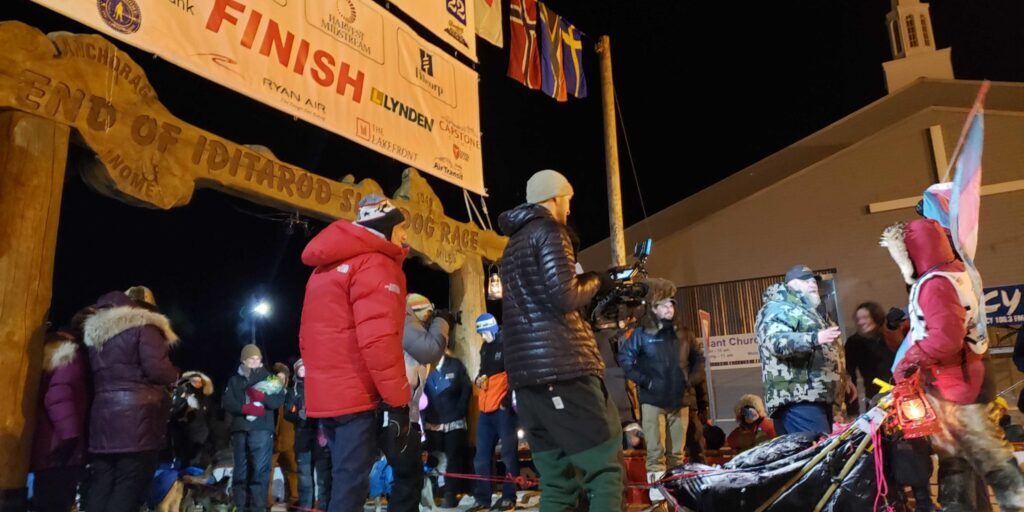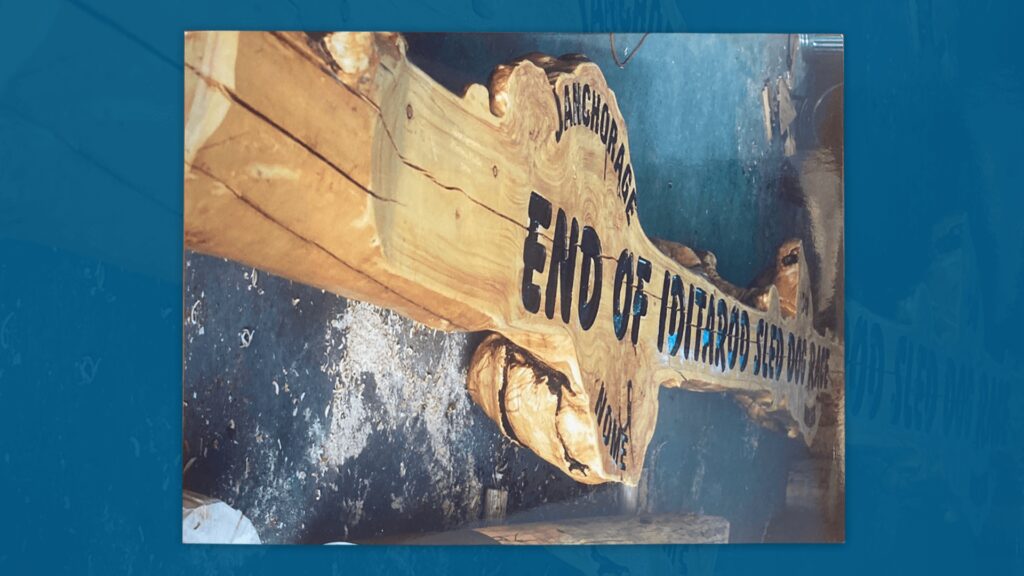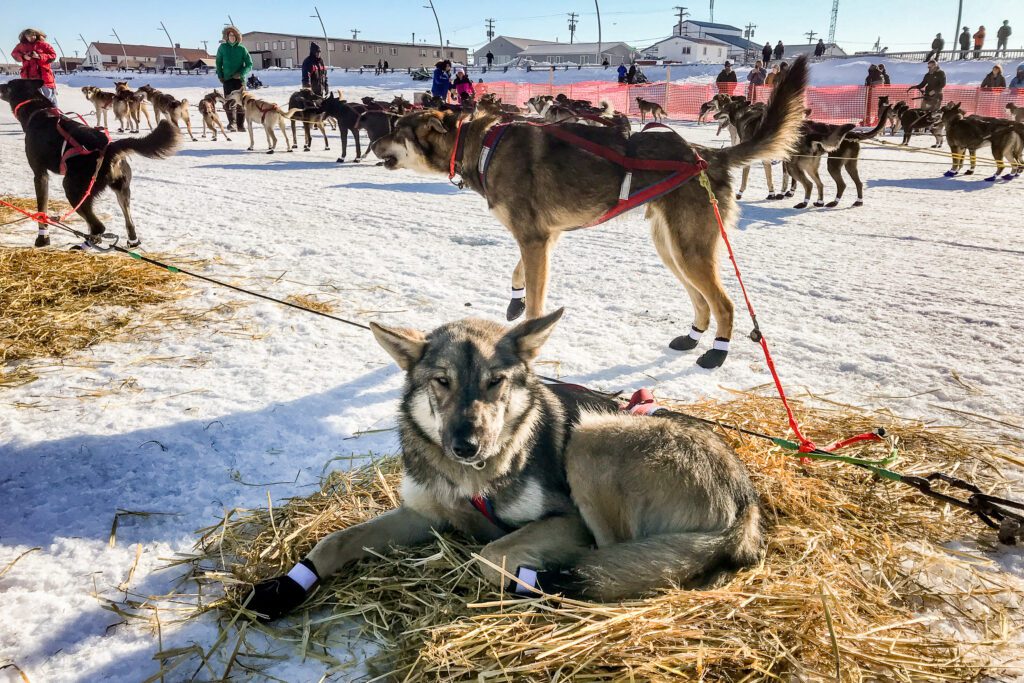KNOM Radio covered the top 25 mushers’ arrival into Nome live this year, during the 50th running of the Iditarod sled dog race. Below you’ll hear from each of the top 25 and also a couple extra mushers including this year’s “Red Lantern” Apayuaq Reitan.
Brent Sass finished the 2022 Iditarod in eight days, 14 hours and 38 minutes, arriving under the burled arch at 5:38 a.m. in Nome on Tuesday, March 15. He ended up finishing over an hour ahead of second place musher, Dallas Seavey, but could have had even more separation if it wasn’t for a nasty weather event he ran into near Cape Nome.
2nd: Dallas Seavey was looking for that incredible sixth Iditarod victory, something that has never been done before. Instead he settled for second place, chasing Brent Sass for two-thirds of the 50th Iditarod race. He came into Nome on Tuesday morning at 6:46 a.m., in eight days, 15 hours and 46 minutes.
3rd: Jessie Holmes had his best Iditarod yet, despite arriving into Nome more than 12 hours behind Sass and Seavey. His team of nine dogs seemed to get faster and faster from the Yukon River onto the Norton Sound and then cruising into Nome at 7:39 pm on Tuesday, March 15. His total race time was nine days, four hours and 39 minutes.
4th: Similarly, Dan Kaduce had his best Iditarod finish this year, but even more impressive was his achievement of bringing a full team of all 14 dogs to Nome. He was the only musher in this year’s race to do that. Kaduce pulled under the burled arch less than 30 minutes behind Jessie Holmes, in nine days, five hours and four minutes. Kaduce also received the Leonhard Seppala Humanitarian award for his “outstanding dog care during the race while also staying competitive.”
5th: Another top ten finish for Bethel’s own Pete Kaiser, the 2019 Iditarod Champion. This year Kaiser had the honor of carrying another Iditarod victor’s ashes along the trail with him. The family of Richard “Dick” Wilmarth asked Kaiser before the race to take Wilmarth’s ashes with him in his sled all the way to the finish line in Nome. Kaiser made it to the burled arch in nine days, six hours and 45 minutes.
6th: Richie Diehl of Aniak tied his highest place finish from 2018 this year. He notes that so far in his mushing career, his highest achievement is winning the 2021 Kuskokwim 300 race. Diehl got to Nome with eight dogs this year, in nine days, seven hours and two minutes.
7th: Although not technically a rookie, Chad Stoddard had never competed in an Iditarod that finished in Nome. His first Iditarod was the 2021 Gold Loop. And to have a top ten finish while running Dallas Seavey’s B-team was a great accomplishment for Stoddard. During the Iditarod Finisher’s Banquet in Nome, he was named the most improved musher for the 2022 race as well. He passed Aaron Burmeister on the last stretch from Safety to Nome, to finish with a total time of nine days, eight hours and 28 minutes.
8th: Aaron Burmeister of Nome said before this race even began that this would likely be his last Iditarod for the foreseeable future. In this 50th running of the Iditarod he was still unable to achieve his childhood dream of winning the Last Great Race, but Burmeister told KNOM he enjoyed it, especially his time through the Norton Sound communities. His finishing time this year was nine days, eight hours and 35 minutes. He brought the smallest number of dogs in his team to Nome, with only six dogs at the finish line in the 2022 Iditarod.
9th: Ryan Redington continues to carry his family legacy forward, being the only Redington family member to compete this year. He was the first musher to arrive into Nome on Wednesday instead of Tuesday, coming in at 12:26 am with a finishing time of nine days, nine hours and 26 minutes.
10th: Aaron Peck achieved his first top ten finish of his Iditarod career. He told Alaska Public Media and KNOM’s trail reporter that he’s pushing for a Canadian to win the Iditarod in the near future, if not himself then someone from his kennel or another Canadian musher. Peck finished this year’s race in nine days, 12 hours and ten minutes with seven dogs.
11th: The 2018 Iditarod champion Joar Leifseth Ulsom finished just outside of the top ten this year. But he received a special recognition, he won the Nome Kennel Club award for having the fastest time from Safety to Nome, at two hours and 26 minutes. This was Ulsom’s first time winning that award. His total race time this year was nine days, 16 hours and 48 minutes, finishing with seven dogs on the line.
12th: Travis Beals has had three top five finishes in the last five years, but just missed it this year. He came into Nome with seven dogs just about an hour after Joar Ulsom. Beals was given special recognition by his fellow mushers this year through the 2022 Sportsmanship award. Beals was given the award for his generosity in giving one of his sleds to Chad Stoddard in Unalakleet who was able to get to Koyuk and then return it to Beals there.
13th: Ramey Smyth was only 11 minutes behind Beals, pulling under the burled arch at 8:50 am on Wednesday, March 16. He was in the middle of a competitive pack as Mille Porsild finished behind him just six minutes later. Smyth had eight dogs on the line and finished with a total race time of nine days, 17 hours and 50 minutes.
14th: Mille Porsild seemed to have a rough go this Iditarod. She described this year’s race as “kicking her and her team’s butts”. Arriving into Unalakleet, Porsild was already on a broken sled, held together with a wrench and zip ties. She was able to switch out sleds thanks to Mitch Seavey, but once she made it to Nome, she told KNOM she wrecked a few times between Safety and Nome and reportedly lost some of her gear from the sled bag. Despite all of that, in three years of Iditarod racing she has won Rookie of the Year, the Leonhard Seppala Humanitarian award, never finished lower than 15th, and was the highest placed female musher this year.
15th: This year marked Matt Hall’s fourth Iditarod and his fastest finishing time into Nome thus far. He arrived with nine dogs in nine days, 18 hours and 21 minutes.
16th: The three time champion Mitch Seavey slipped back in the standings by the time the race reached Unalakleet and the Norton Sound coast this year. However, he still holds the fastest record for winning the Iditarod thus far with eight days, three hours and 40 minutes. In this year’s race he finished in nine days, 19 hours and 19 minutes with eight dogs.
17th: Michelle Phillips has completed 12 Iditarods but has yet to crack the top ten. In years past her main focus has been the Yukon Quest, and she trains near portions of that trail in the Yukon Territories where her Tagish Lake kennel is located. This year Phillips finished in nine days, 21 hours and 52 minutes with nine dogs.
18th: This year’s Iditarod was Lev Shvarts’ fastest and best place finish to Nome. He placed 17th last year during the Gold Loop trail, but that route did not end in Nome. Shvarts, like many this year, struggled with weather and strong winds along the Norton Sound coast, but finished in high spirits with his usual sense of humor during the finish line interview. His total race time was nine days, 22 hours and three minutes with eight dogs.
19th: Rookie of the Year, Hanna Lyrek of Norway followed in her mother’s footsteps and achieved what she described as a childhood dream, to finish an Iditarod. Lyrek finished her first Iditarod in ten days, two hours, and 43 minutes. For comparison, her mother Trine finished her first Iditarod in 2005 more than a day later than Hanna.
Unfortunately KNOM’s live coverage of Lyrek’s finish was not fully recorded, but you can hear parts of her story below in the audio file from Paige Drobny’s finish under the burled arch in Nome.
20th: Paige Drobny has now completed eight Iditarods, with her highest finish being 7th place. For part of this year’s race she ran alongside Hanna Lyrek, helping her navigate the Norton Sound coast and looked out for each other on the trail as they headed to the finish line. She finished seconds behind Lyrek with a total race time of ten days, two hours and 43 minutes plus 43 seconds.
21st: This year was Martin Massicotte’s first Iditarod finish. He competed in the 2020 Iditarod but scratched before reaching Nome. His total race time this year was ten days, eight hours and 17 minutes with ten dogs.
22nd: Mats Pettersson is from Kiruna, Sweden and has run the Iditarod seven times with no scratches but also no top ten finishes thus far. He finished this year’s race with a race time of ten days, eight hours and 37 minutes with seven dogs.
23rd and 24th: Twin sisters, Anna & Kristy Berington came into Nome together, officially checking in about a minute apart. Kristy struggled more than her sister this year and had a team of seven dogs for a large portion of the race before finishing with six in total. However she credited Anna for continuing to push her from checkpoint to checkpoint so she could still finish alongside her. Both crossed the finish line in ten days, eight hours and 44 then 45 minutes respectively.
25th: This was Joe Taylor’s first Iditarod and some of his friends back home in California were even betting on him not finishing the race. But Taylor made the top 25 in his first go, no easy feat. His total race time was ten days, 21 hours and ten minutes. Taylor took 12 of his dogs from his Mushing Malarkey kennel in Ester all the way to the finish line in Nome.
BONUS: Four-time champion Martin Buser finished 26th this year in what would be the longest standing record of 39 consecutive Iditarod finishes. He also won the Herbie Nayokpuk Memorial award this year for “emulating Herbie: The Shishmaref Cannonball” along the trail. Buser finished less than ten minutes after rookie Joe Taylor, with a total race time of ten days, 21 hours and 17 minutes.
Red Lantern: The final musher to finish this year’s race was Apayauq Reitan! Several teams dropped out of the race around her, especially on the last stretch of trail from White Mountain to Nome even on the same day; but just before midnight Saturday, March 19, Reitan crossed under the burled arch. Her total race time was 13 days, eight hours and 39 minutes with seven dogs.
Image at top: Apayuaq Reitan of Kaktovik came into Nome as the “Red Lantern” in the 2022 Iditarod sled dog race. Photo from Davis Hovey, KNOM (2022)







